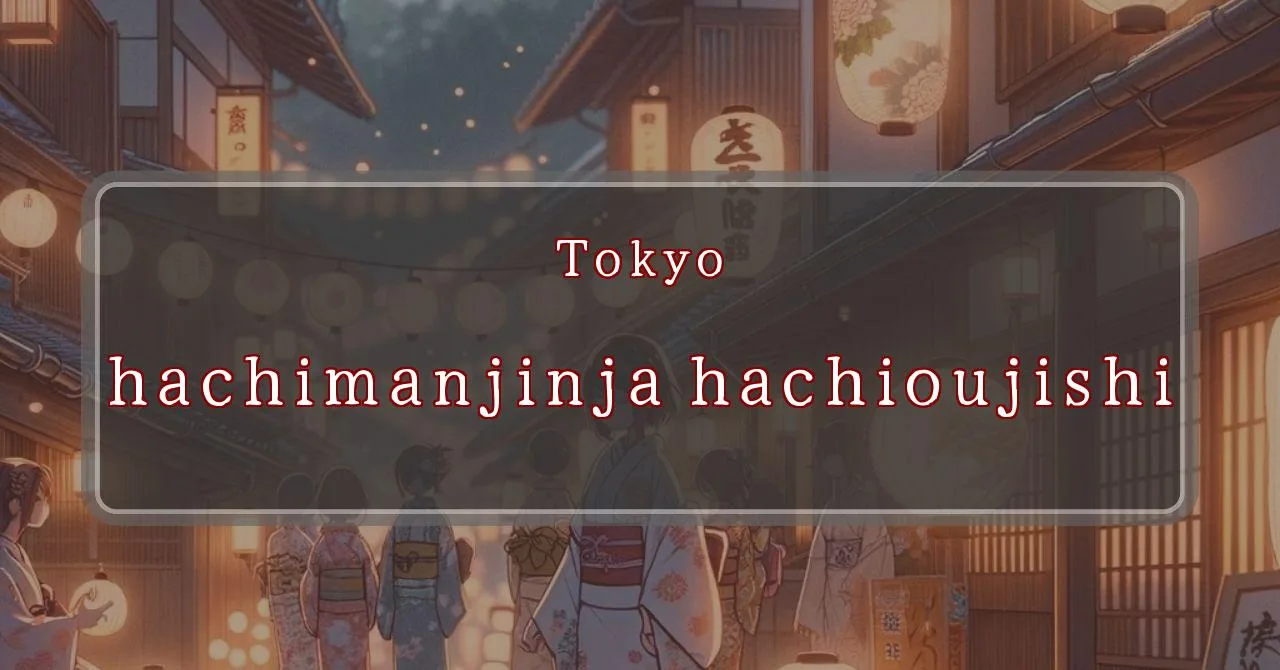Gleaming lanterns illuminate the summer night
Basic Information
Hachiman Yakumo Shrine is a Shinto shrine located in the center of Hachioji City, Tokyo, Japan. It is dedicated to the deities Hachiman and Susanoo-no-Mikoto.
- Address: 2-15-27 Motoyokoyama-cho, Hachioji-shi, Tokyo 192-0063
- Phone Number: 042-623-0720
- Access: 10-minute walk from JR Hachioji Station North Exit or Keio Hachioji Station
- Festival Days: August 20th (Sun), 2024
Main Events and Attractions of the Festival
The Hachioji Matsuri is a lively and colorful festival that takes place annually in Hachioji City, Tokyo. The festival features a variety of events and attractions, including:
Mikoshi Procession
One of the main highlights of the festival is the mikoshi procession. Mikoshi are portable shrines that are carried through the streets by teams of people. The mikoshi are decorated with elaborate carvings and ornaments, and they are believed to be inhabited by the spirits of the gods. During the procession, the mikoshi are carried through the streets, accompanied by music and dancing.
Floats
Another popular attraction of the festival is the floats. The floats are large, elaborately decorated platforms that are pulled through the streets by teams of people. The floats are often adorned with scenes from Japanese mythology or history, and they are a popular spot for people to take photos.
Performances
The festival also features a variety of performances, including traditional Japanese music and dance, as well as more modern performances such as pop concerts and DJ sets. There is something for everyone to enjoy at the Hachioji Matsuri.
Food and Drink
No Japanese festival is complete without food and drink, and the Hachioji Matsuri is no exception. There are many food stalls set up throughout the festival grounds, selling a variety of delicious Japanese dishes and snacks. There are also plenty of places to buy drinks, both alcoholic and non-alcoholic.
Blessings and Deities
Hachiman Yakumo Shrine is dedicated to two deities: Hachiman and Susanoo-no-Mikoto. Hachiman is the god of war and archery, and is also revered as the protector of the nation and the people. Susanoo-no-Mikoto is the god of storms and the sea, and is also known for his role in slaying the eight-headed serpent, Yamata no Orochi.
- Hachiman: God of war and archery, protector of the nation and the people
- Susanoo-no-Mikoto: God of storms and the sea, slayer of the eight-headed serpent, Yamata no Orochi
Origin and History
The origins of Hachiman Yakumo Shrine can be traced back to the 10th century, when a local warlord named Ono Yoshikage built a shrine to Hachiman on the site of the present-day shrine. In the 12th century, the shrine was expanded and dedicated to both Hachiman and Susanoo-no-Mikoto. The shrine has been a popular place of worship for centuries, and it is especially revered by local residents.
- 10th century: Ono Yoshikage, a local warlord, builds a shrine to Hachiman on the site of the present-day shrine
- 12th century: The shrine is expanded and dedicated to both Hachiman and Susanoo-no-Mikoto
- Present day: The shrine is a popular place of worship for centuries, and it is especially revered by local residents
Tips and Notes for Visitors
If you are planning to visit Hachiman Yakumo Shrine, here are a few tips and notes to keep in mind:
- The shrine is open daily from 9:00 AM to 5:00 PM.
- Admission to the shrine is free.
- There is a small museum on the shrine grounds that houses a collection of artifacts related to the shrine’s history.
- The shrine is a popular spot for weddings and other ceremonies, so it is best to avoid visiting during these times if you are looking for a quiet and peaceful experience.
- There are several restaurants and shops located near the shrine, so you can easily find a place to eat or buy souvenirs.
Parking Information
There is a small parking lot located on the shrine grounds, but it is often full, especially during peak times. If you are driving to the shrine, it is best to arrive early or park in one of the nearby public parking lots.
- There is a small parking lot on the shrine grounds, but it is often full
- Arrive early or park in one of the nearby public parking lots
Popular Stalls and Food Carts in Recent Years
| Type of Stall | Description |
|---|---|
| Takoyaki | A staple at Japanese festivals. Characterized by a crispy outside and a creamy inside. |
| Jaga Butter | A simple yet popular snack of hot potatoes lavishly topped with melted butter. |
| Baby Castella | Small castella cakes, sweet and fluffy treats enjoyed by children and adults alike. |
| Grilled Ayu with Salt | Fresh ayu fish grilled whole with salt, a savory taste of Japanese summer. |
| Shaapin | A unique gourmet item influenced by foreign cuisine, with a chewy skin wrapping the filling. |
| Okonomiyaki | A Japanese grilled dish where you often choose your own ingredients for a personalized flavor. |
| Cotton Candy | A fluffy, sweet snack that’s extremely popular with children. |
| Chocolate Banana | A banana coated in chocolate, a fun and visually appealing dessert. |
| Kushiyaki | Various types of ingredients skewered and grilled, an easy-to-enjoy snack. |
| Yakisoba | Fried noodles mixed with a special sauce, a fast food favorite in Japan. |



